Like Shakespeare’s quill, Michael Angelo’s brush, and Marie Curie’s bunsen burner - the sales engagement platform is the well-used ‘workhorse’ tool through which the most talented sales professionals work their magic.
This is backed up by Gartner research. In a 2021 study, sales engagement platforms were found to have an average of 60% of their users active daily (in contrast with an average of 10-20% daily active users across other enterprise applications).
It’s not just important to your reps - it’s vital to your prospects, too, as sales engagement platforms often have client-facing elements. Both buyer and seller are reliant on your choice of sales engagement platform - the tool you choose must provide solid processes with visually impressive, easy-to-use interfaces.
But in an overcrowded and often confusing sales tool market, where everyone from the humblest Chrome extension to the largest customer relationship management (CRM) system is looking to diversify and offer services adjacent to their core offer, it can be difficult to choose the right tool for your team.
Key takeaways
- Salespeople spend more time using sales engagement tools than any other type of sales tool.
- Sales engagement tools are integral to the buyer experience - robust, visually impressive tools for client-facing tasks are essential.
- Many sales software platforms offer a range of tools, with many crossover products offering some elements for sales engagement, so choosing a tool can be difficult.
What is sales engageement software?
Sales engagement software is where your reps live. Usually, the second item in a sales tech stack (directly after the CRM), the sales engagement platform draws together various tasks and functions into a streamlined system.
Sales engagement platforms help sales reps by focusing their sales activities around a single dashboard or UI, so they don’t have to try to pull data and operate multiple systems at once.
Sales engagement tools can also be for a specialized specific use, operating as part of a wider suite of tools where another tool (like another sales engagement platform, or even a sales CRM) is used to provide the main ‘source of truth’ into which all other tools are integrated.
This is why CRMs like Salesforce and Microsoft Dynamics are increasingly providing their own sales engagement tools, either as add-ons within the main ecosystem, or standalone products.
To further muddy the waters, many sales engagement tools also include features you’d associate with sales enablement, such as AI-driven coaching that provides insights for reps and other team members.
The main difference to keep in mind is that sales engagement tools are geared towards improving the quality of the customer journey. Anything that aids communication between seller and buyer can and should be considered a sales engagement tool.
How to choose the right sales engagement software solution
Your business needs, selling environment, and existing tech stack will determine what should be in your sales engagement toolkit. As we’ve already said, though the standard implementation is based around one central sales engagement platform as a single source of truth, there are still plenty of use cases for standalone tools and specialized add-ons.
Any good sales engagement tool should drive three main benefits for your sales operation.
- Increased sales productivity
- Better sales intelligence
- Higher quality buyer and seller interactions
Features to look for in a sales engagement software solution
When you’re considering adding a tool to your sales engagement tech stack, there are some key features you want to ensure that are included to get the most return on your investment.
These features are grouped based on the benefit to your organization and include:
Increased productivity
Achieved through time-saving features like scheduling tools, single dashboard/centralized data/integrations, and cadence creators. Most automation features, such as automated data entry or automated scheduling, also come under this heading of features designed to give salespeople more time to sell and close deals rather than carry out routine and repetitive tasks.
Better sales intelligence
Analytics implementation is now table stakes for sales engagement tools. Other features designed to provide sales intelligence are often built around AI capabilities - such as conversation intelligence tools that suggest a ‘next best action’ or offer coaching tips based on call content.
This category could also include lead-scoring tools and instant notifications about target account activity.
Higher quality buyer and seller interactions
Made possible by engagement features that directly impact the customer experience. These include multi-channel communication capability (including social media, SMS, live chat, and chatbots), personalization tools, and tools for creating and managing standardized content.
The five best sales engagement software in 2024
Here’s a rundown of the five best options for sales teams looking to hone their sales engagement capabilities and create an even better buyer experience. We’ve primarily concentrated on the broader style of sales engagement platforms for our list (although we’ve included specialist tools with a narrower purpose where something’s so good we don’t want you to miss out).
We’ve also given a rundown at the end of some other interesting up-and-coming sales engagement tools you might be interested in.
Apollo.io
Apollo offers a robust, integrated sales engagement platform with powerful, well-sourced prospecting tools for lead generation and engagement tools to build sophisticated automated touchpoint sequences, native phone call capabilities (with CRM integration), task manager, and much more.
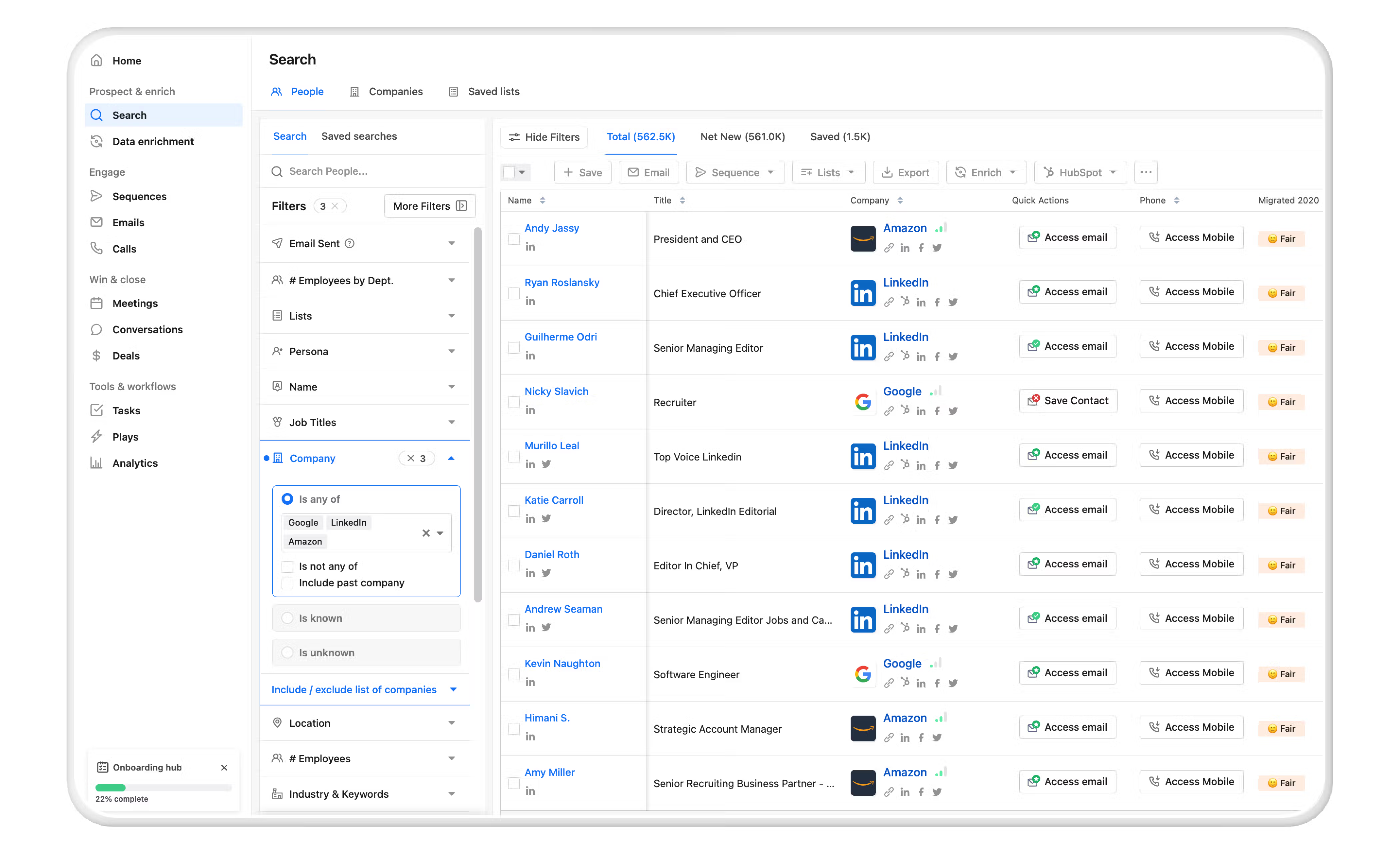
Primary use cases: Apollo.io is a comprehensive platform for sales prospecting and engagement.
Standout features: Advanced prospecting tools, powerful scheduling features with inbound routing rules, and hyper-personalized email AI. The data health center is also helpful in identifying gaps in your CRM data.
Templates: Apollo.io provides templates for outreach and communication across multiple channels, including email and LinkedIn.
Tracking & analytics: Tracks messaging effectiveness, rep activity, team performance, and ROI using Apollo’s pre-built suite of reports and dashboards.
Integrations: Integrates with CRM systems and other sales tools, with self-serve integrations available via Zapier.
Customer support: Live chat and technical support are provided, with priority email support on all paid plans.
Pricing: There’s a free plan available. Paid plans include Basic ($49 per user/month), Professional ($79 per user/month), and Organization ($119 per user/month).
Outreach.io
One of the two market leaders in sales engagement (alongside Salesloft), Outreach.io is ideal for teams looking to streamline their sales processes, using their Knowledge AI Assistant (or Kaia for short) to develop ever more sophisticated automation and sales enablement support, decreasing rep ramp time.
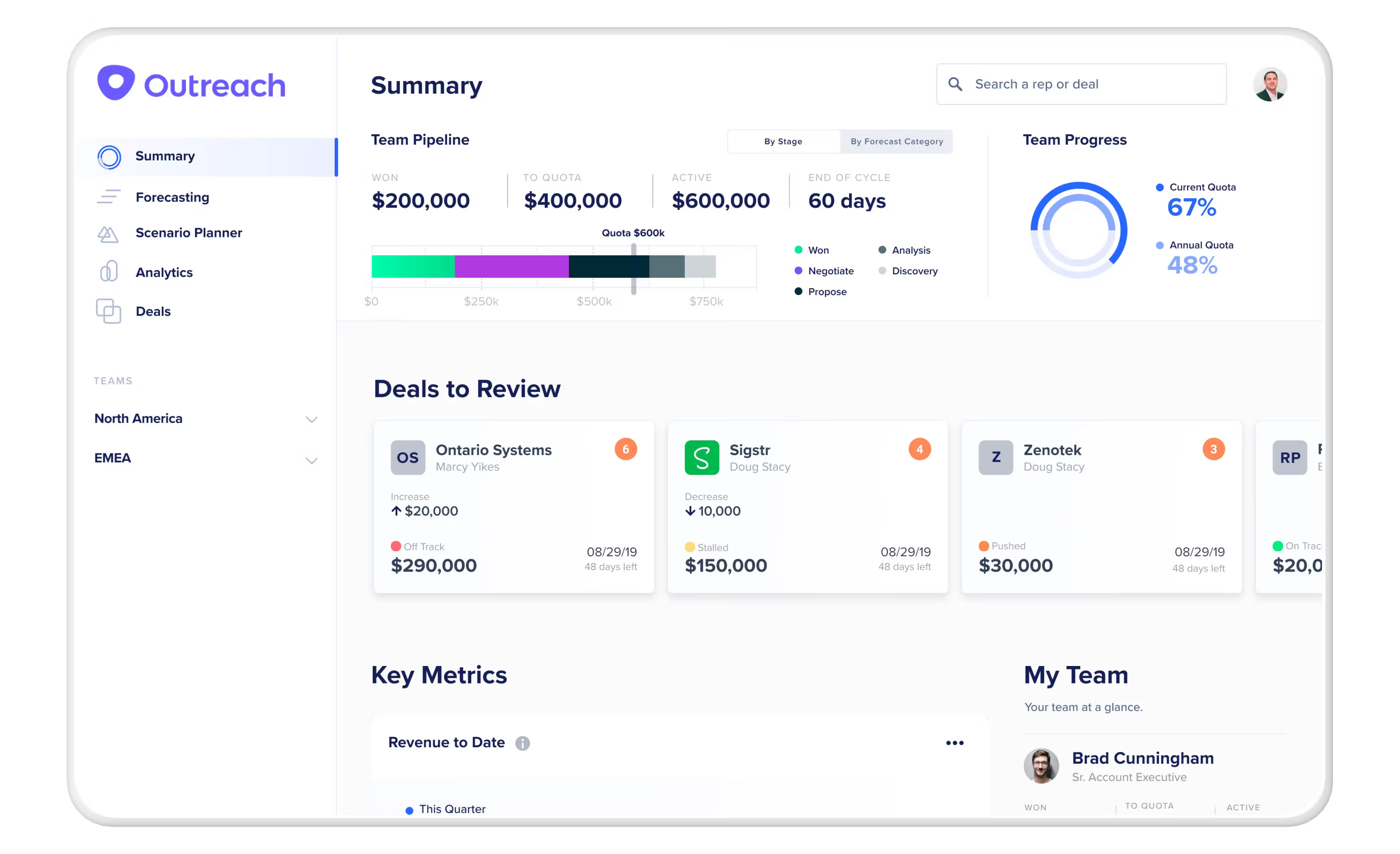
Primary use cases: Outreach.io is a sales engagement platform focused on outreach automation and sales productivity through a ‘single pane of glass.’
Standout features: Advanced automation, conversation intelligence and rep coaching, and sales pipeline management.
Templates: Outreach leverages templates for many of its processes, including personalized Gmail templates and well-designed internal documents like sales rep Success Plans.
Tracking & analytics: Activity-based analytics provide valuable insights into a surprising range of data - as well as standard reporting metrics connected to rep activity and performance; you can use analytics to find extra details, such as the best time to email individual contacts at target accounts.
Integrations: 100+ integrations across CRM, communication, and revenue management tools.
Customer support: customer knowledge base, online billing portal, live chat, and multiple channels available according to the level of your support plan. Support team available Mon-Fri.
Pricing: Four tiers, two for sales teams, two for enterprise - prices on request, but review sites report subscriptions starting somewhere around the $100 per user/month mark.
Qwilr
Although Qwilr doesn’t provide users with a ‘one-stop-shop’ experience, it nevertheless earns its place in this line-up, thanks to best-in-class proposal software and content creation tools that allow sellers and buyers to enjoy visually stunning, interactive sales proposals and documents.
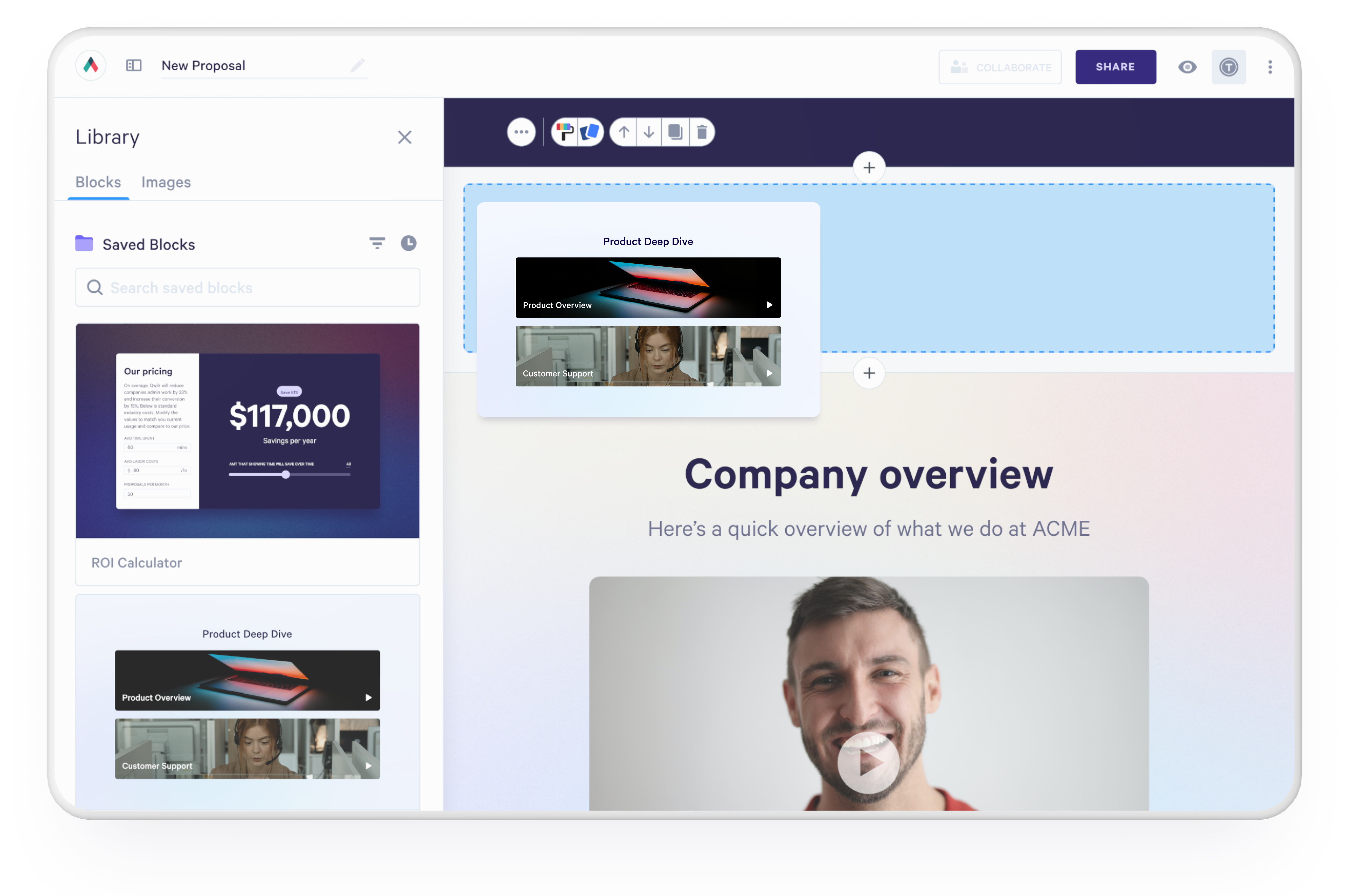
With e-signature and embedded payment features, powerful analytics, and easy-to-use customizable proposal templates that you can instantly update to reflect changes in the sales conversation, Qwilr is a sales engagement essential.
Primary use cases: Qwilr is primarily for creating visually appealing and interactive sales proposals and documents, making a strong impression on clients.
Standout features: Interactive document creation and customization, team e-signature functionality, and powerful analytics.
Templates: More than 100 templates built to mirror popular sales methodologies like gap selling, SPIN, and MEDDIC.
Tracking & analytics: Tracks a range of interactions with sales collateral, including pages viewed and length of engagement.
Integrations: Enjoy native integrations with Slack, HubSpot Sales Hub, and Salesforce, or use Zapier to link Qwilr to hundreds of different sales and business productivity tools.
Customer support: A vast online knowledge hub offers a range of media and resources, and email support is only ever a click away.
Pricing: Qwilr offers a transparent two-tier pricing plan, with free trials available on both tiers. The Business package is available for $35 USD per user/month, while the Enterprise tier (with additional security features, integrations, training, account management, etc.) costs $59 per user/month.
You can also try Qwilr's AI proposal generator for free and create your own professional looking proposal in minutes.
SalesLoft
The other big player on our list, SalesLoft, is renowned for effortlessly automated cadence management and intuitive, easy-to-use team collaboration tools. If you need a tool to smooth out the sticking points in team selling situations, SalesLoft is the one for you.
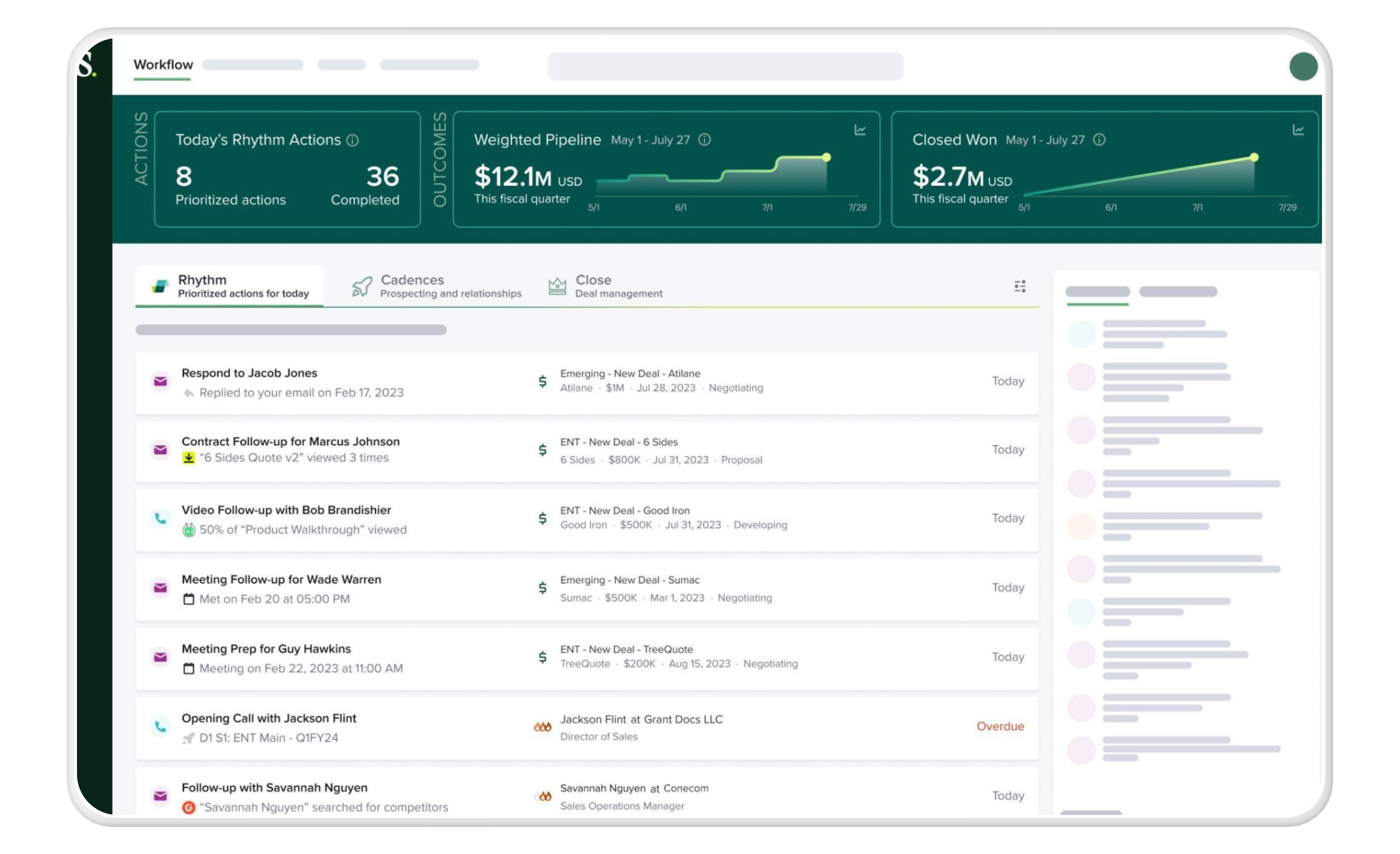
Primary use cases: SalesLoft is a sales engagement platform focusing on automation and collaboration.
Standout features: Sales automation, cadence management, and team collaboration tools.
Templates: SalesLoft provides templates for personalized and automated sales outreach.
Tracking & analytics: Robust analytics for tracking prospect engagement and team performance.
Integrations: Over 100 native integrations, plus the ingenious SalesLoft Labs, where tech-savvy sellers create and trade new plugins and apps built to enhance the platform still further.
Customer support: Knowledge center, live chat, and technical support are matched to your tiered package.
Pricing: Pricing is provided on request, though online review sites report the entry-level package as costing $75 per user/month, with features like conversation intelligence and revenue forecasting reserved for the higher tiers.
Gong.io
Gong leans heavily into its excellent conversation analytics and AI-driven coaching to earn its place on our list. For organizations looking to augment their sales enablement provision, Gong can provide a great cost-effective solution.
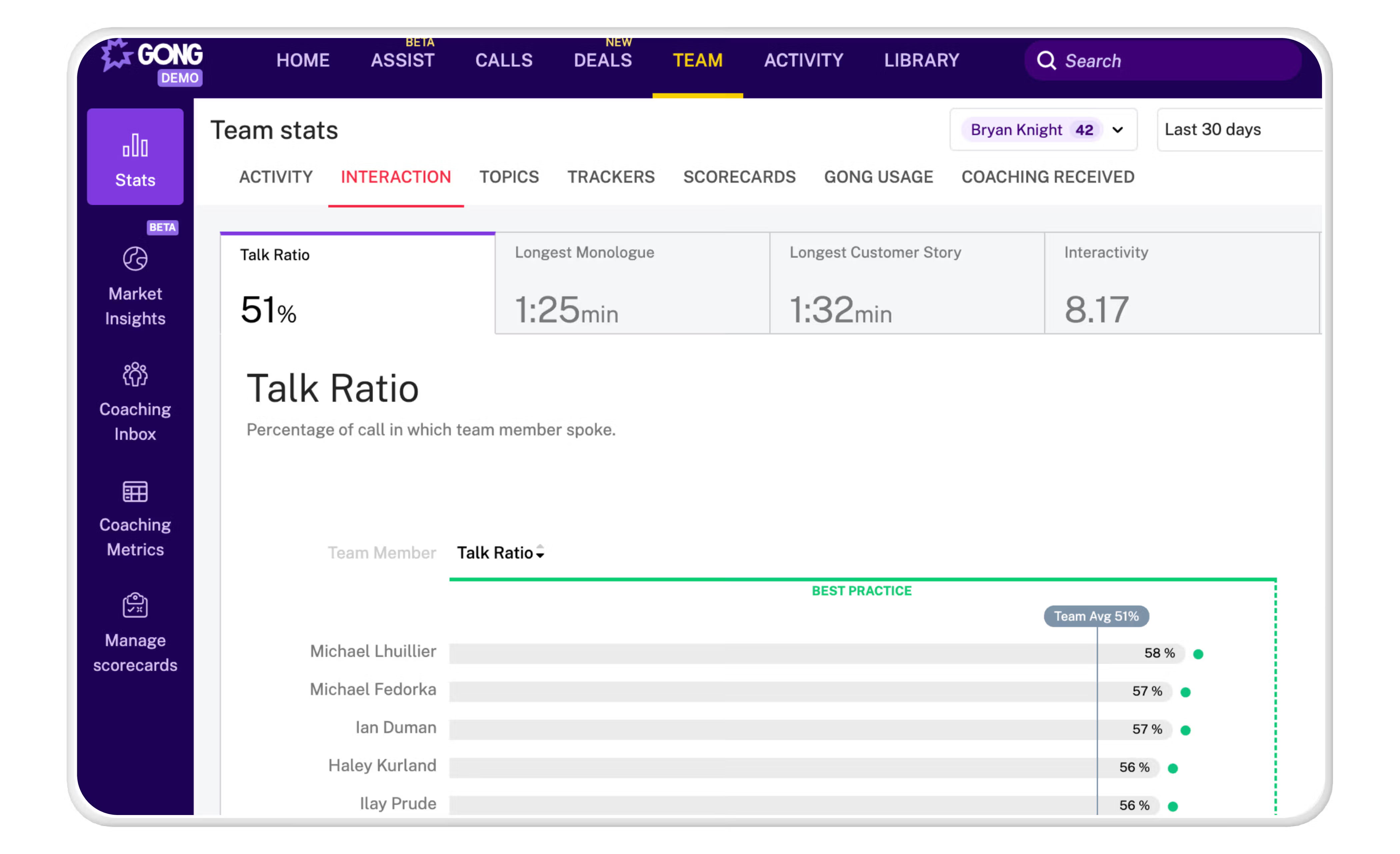
Primary use cases: Gong analyzes sales calls, meetings, and demos in real-time, providing AI-driven insights to improve sales performance and highlight best practices.
Standout features: Robust integrations and excellent proactive customer support.
Templates: Gong provides various email templates to aid content creation.
Tracking & analytics: Gong analytics are a major selling point, with detailed analytics on sales calls, including talk-to-listen ratio, customer sentiment, and key discussion points. Gong also provides insights into deal progression and individual performance metrics.
Integrations: Popular CRM platforms like Salesforce and HubSpot are fully integrated, along with email and video-conferencing platforms like Zoom and Microsoft Teams
Customer support: Extensive knowledge hub, a multi-channel product team, and a dedicated onboarding rep to help you get the most from your Gong implementation.
Pricing: Gong doesn’t list prices on the website, but review sites across the web report their packages start at around $1,400 per user per year (or roughly $120 per user/month)
Other sales tools to explore
Lavender
This sales email coach and personalization assistant offers great value for money (and even offers their product for free to jobseekers for extra social value). Their score-based email AI provides tips to warm up your cold emails, with neat sliders to ‘dial in’ the exact amount of creativity or informality appropriate to your communications.
The ‘Teams’ tier (at $69 per user/month) offers data-backed insights to help managers offer coaching to their reps. The free trial is available on the ‘Pro’ tier, which offers ‘unlimited everything’ for $49 per user/month.
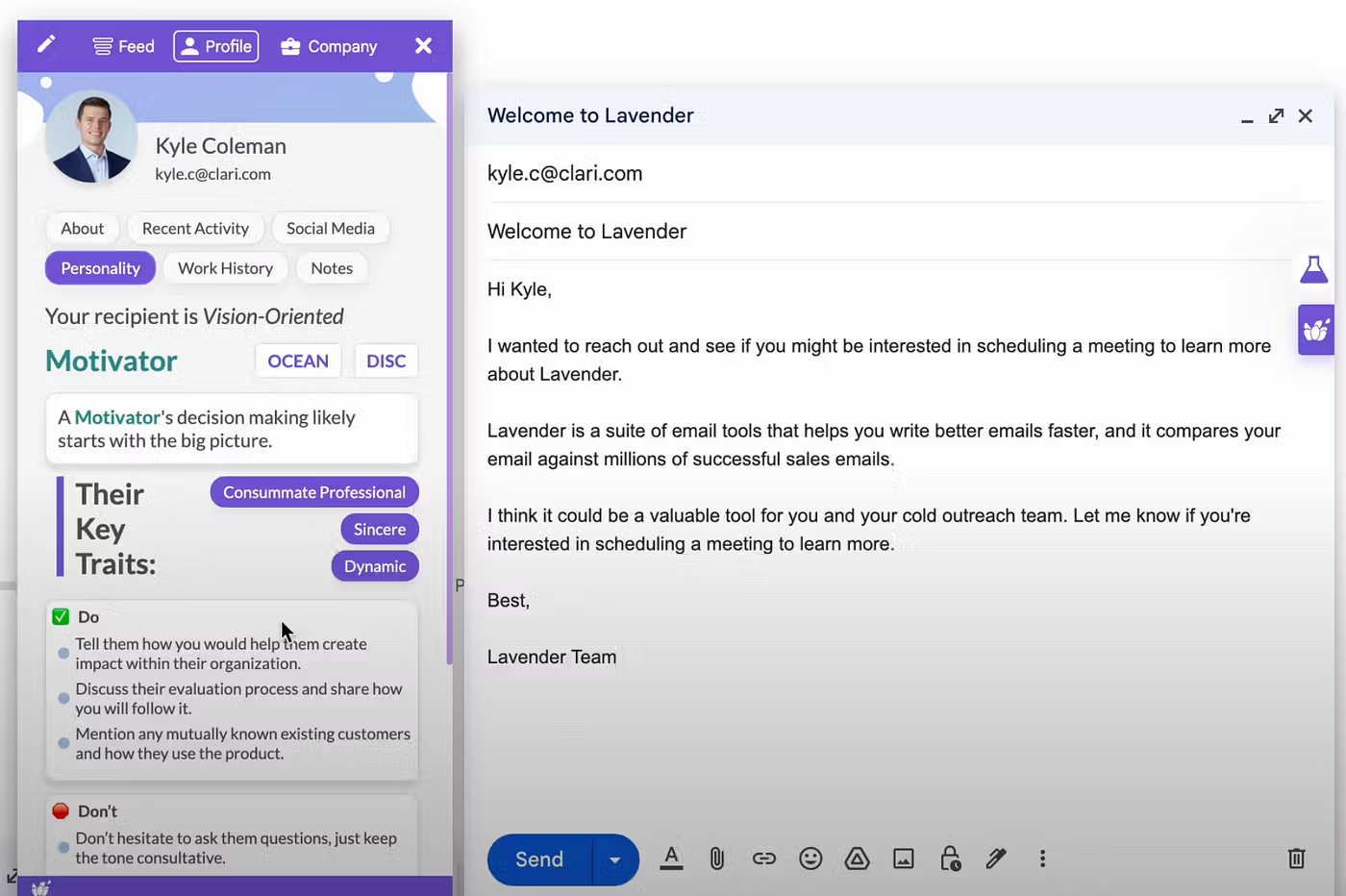
Woodpecker
Woodpecker offers three products designed specifically for outreach, with an emphasis on email campaigns.
The first, Cold Email, personalizes and automates your cold email sequences and uses a bounce shield to keep your sales cadences safely within sending limits from major email providers such as Gmail and Outlook.
The second product, Sales Assistant, introduces an additional communication channel approach to the mix, adding automated LinkedIn and phone call functionality alongside a flexible scheduler/planner.
The third Woodpecker tool, Agency, allows you to pull all your outbound campaigns and accounts into a single account and adds white labeling features.
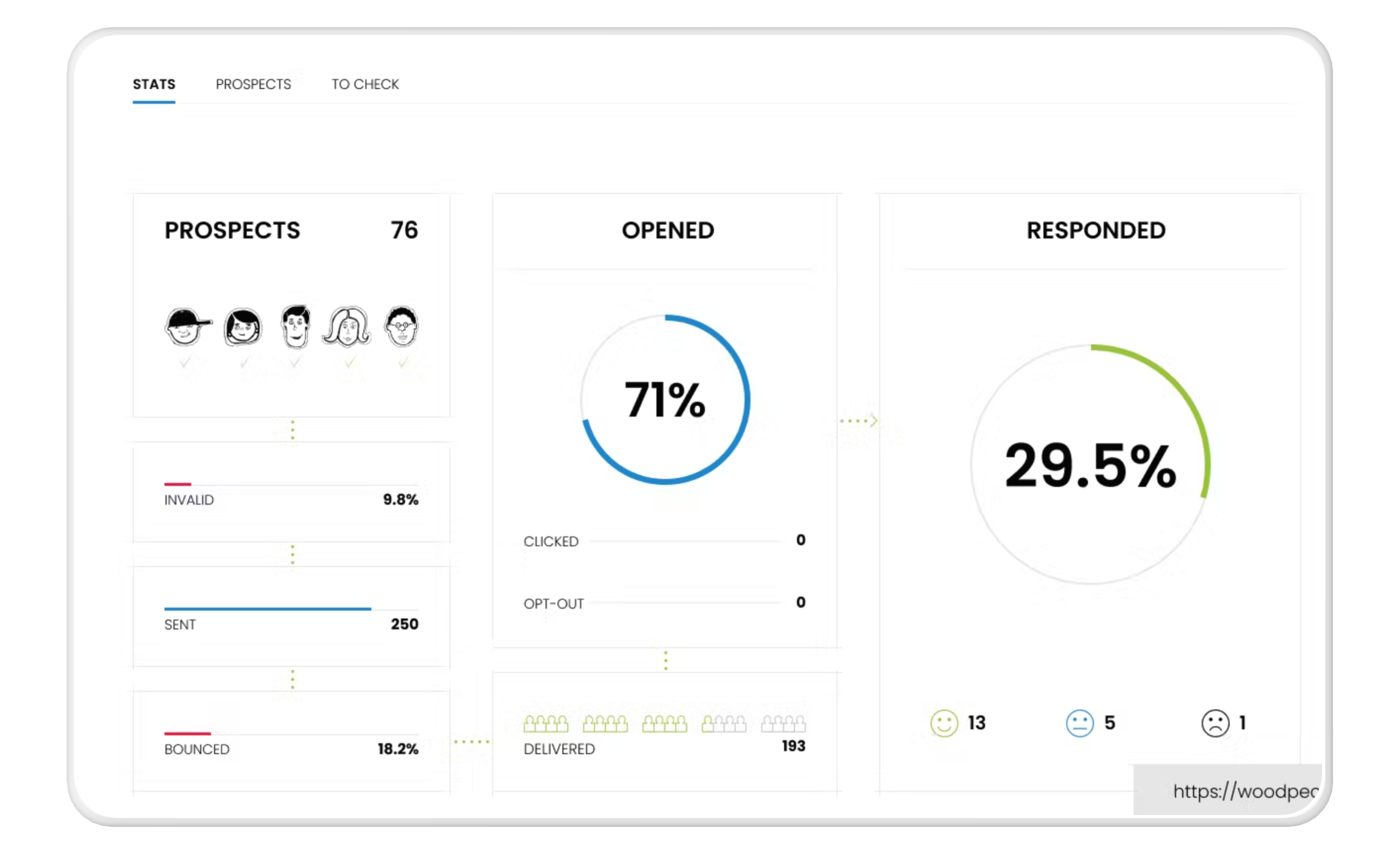
Clari
Clari’s all-encompassing suite of revenue tools got even more interesting back in 2021 with their acquisition of Groove - one of the industry’s most highly-regarded sales engagement and prospecting tools.
Although Groove is Salesforce-specific (bad news for other CRM users), it’s got some great features, including a host of workflow automations and some seriously impressive AI-driven guided selling capabilities, allowing users to manage interactions with consistency and precision.
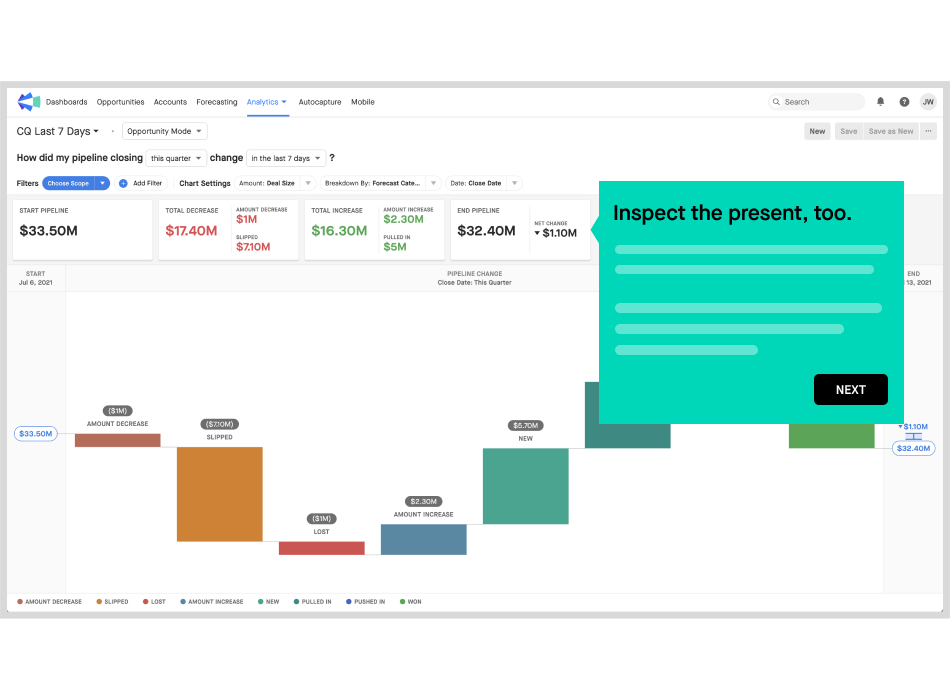
Qualified
Qualified will do wonders for your website and help you maximize every possible aspect of your domain.
Just plug Qualified in, and you can build features like video-capable live chat, chatbots, embedded scheduling tools, and personalized marketing offers - all natively hosted by Qualified.
If you’re a Salesforce Sales Cloud user, things get even better, as Qualified can cross-reference, identify and capture analytics data about site visitors from your CRM contacts and leads, letting you follow up quickly and effectively on their interest.

FAQs
What’s the difference between sales engagement and sales enablement?
Sales enablement describes activities that help salespeople improve their sales performance (such as coaching or developing playbooks). Sales engagement is focused on improving customer interactions and communication between sellers and buyers.
Do I need a sales engagement platform if I’ve got a CRM?
Although many CRMs now offer effective sales engagement solutions and capabilities, it’s important to ensure that your sales professionals have a ‘single source of truth’ that’s easy to use and minimizes the time spent on routine tasks. This is often achieved by using a separate sales engagement platform that integrates with and feeds data into the CRM.
Are sales engagement tools necessary for sales teams?
According to Gartner analysts, sales engagement platforms are now considered a Level 1 technology alongside CRMs, which means they’re considered a mandatory purchase for all sales development teams, regardless of size.
Optimizing every part of your sales strategy for maximum engagement
While it’s tempting to imagine that with the right CRM and the best sales engagement platform, you can relax and let the tools do the work, experienced sales managers know this is far from the truth.
Even as your team gets up to speed with the capabilities of your sales engagement platform, sales leaders need to keep an eye on the road ahead, looking far beyond the current sales cycle for the next optimization, the next AI-driven innovation that will put their sales process ahead of the competition.
Sales leaders like these have already found Qwilr and put it to good use, creating attractive, interactive sales proposals and collateral.
It’s good to have a tool that can do every job, but it’s even better to have the best tool for every job. Treat your team to a 14-day free trial with Qwilr, and you won’t look back.
About the author

Dan Lever|Brand Consultant and Copywriter
Dan Lever is an experienced brand consultant and copywriter. He brings over 7 years experience in marketing and sales development, across a range of industries including B2B SaaS, third sector and higher education.


